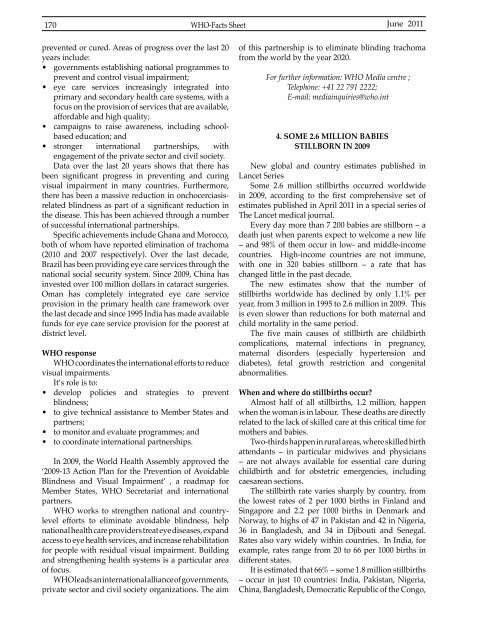Vol 43 # 2 June 2011 - Kma.org.kw
Vol 43 # 2 June 2011 - Kma.org.kw
Vol 43 # 2 June 2011 - Kma.org.kw
You also want an ePaper? Increase the reach of your titles
YUMPU automatically turns print PDFs into web optimized ePapers that Google loves.
170<br />
WHO-Facts Sheet <strong>June</strong> <strong>2011</strong><br />
prevented or cured. Areas of progress over the last 20<br />
years include:<br />
• governments establishing national programmes to<br />
prevent and control visual impairment;<br />
• eye care services increasingly integrated into<br />
primary and secondary health care systems, with a<br />
focus on the provision of services that are available,<br />
affordable and high quality;<br />
• campaigns to raise awareness, including schoolbased<br />
education; and<br />
• stronger international partnerships, with<br />
engagement of the private sector and civil society.<br />
Data over the last 20 years shows that there has<br />
been significant progress in preventing and curing<br />
visual impairment in many countries. Furthermore,<br />
there has been a massive reduction in onchocerciasisrelated<br />
blindness as part of a significant reduction in<br />
the disease. This has been achieved through a number<br />
of successful international partnerships.<br />
Specific achievements include Ghana and Morocco,<br />
both of whom have reported elimination of trachoma<br />
(2010 and 2007 respectively). Over the last decade,<br />
Brazil has been providing eye care services through the<br />
national social security system. Since 2009, China has<br />
invested over 100 million dollars in cataract surgeries.<br />
Oman has completely integrated eye care service<br />
provision in the primary health care framework over<br />
the last decade and since 1995 India has made available<br />
funds for eye care service provision for the poorest at<br />
district level.<br />
WHO response<br />
WHO coordinates the international efforts to reduce<br />
visual impairments.<br />
It’s role is to:<br />
• develop policies and strategies to prevent<br />
blindness;<br />
• to give technical assistance to Member States and<br />
partners;<br />
• to monitor and evaluate programmes; and<br />
• to coordinate international partnerships.<br />
In 2009, the World Health Assembly approved the<br />
‘2009-13 Action Plan for the Prevention of Avoidable<br />
Blindness and Visual Impairment’ , a roadmap for<br />
Member States, WHO Secretariat and international<br />
partners.<br />
WHO works to strengthen national and countrylevel<br />
efforts to eliminate avoidable blindness, help<br />
national health care providers treat eye diseases, expand<br />
access to eye health services, and increase rehabilitation<br />
for people with residual visual impairment. Building<br />
and strengthening health systems is a particular area<br />
of focus.<br />
WHO leads an international alliance of governments,<br />
private sector and civil society <strong>org</strong>anizations. The aim<br />
of this partnership is to eliminate blinding trachoma<br />
from the world by the year 2020.<br />
For further information: WHO Media centre ;<br />
Telephone: +41 22 791 2222;<br />
E-mail: mediainquiries@who.int<br />
4. SOME 2.6 MILLION BABIES<br />
STILLBORN IN 2009<br />
New global and country estimates published in<br />
Lancet Series<br />
Some 2.6 million stillbirths occurred worldwide<br />
in 2009, according to the first comprehensive set of<br />
estimates published in April <strong>2011</strong> in a special series of<br />
The Lancet medical journal.<br />
Every day more than 7 200 babies are stillborn − a<br />
death just when parents expect to welcome a new life<br />
− and 98% of them occur in low- and middle-income<br />
countries. High-income countries are not immune,<br />
with one in 320 babies stillborn − a rate that has<br />
changed little in the past decade.<br />
The new estimates show that the number of<br />
stillbirths worldwide has declined by only 1.1% per<br />
year, from 3 million in 1995 to 2.6 million in 2009. This<br />
is even slower than reductions for both maternal and<br />
child mortality in the same period.<br />
The five main causes of stillbirth are childbirth<br />
complications, maternal infections in pregnancy,<br />
maternal disorders (especially hypertension and<br />
diabetes), fetal growth restriction and congenital<br />
abnormalities.<br />
When and where do stillbirths occur<br />
Almost half of all stillbirths, 1.2 million, happen<br />
when the woman is in labour. These deaths are directly<br />
related to the lack of skilled care at this critical time for<br />
mothers and babies.<br />
Two-thirds happen in rural areas, where skilled birth<br />
attendants − in particular midwives and physicians<br />
− are not always available for essential care during<br />
childbirth and for obstetric emergencies, including<br />
caesarean sections.<br />
The stillbirth rate varies sharply by country, from<br />
the lowest rates of 2 per 1000 births in Finland and<br />
Singapore and 2.2 per 1000 births in Denmark and<br />
Norway, to highs of 47 in Pakistan and 42 in Nigeria,<br />
36 in Bangladesh, and 34 in Djibouti and Senegal.<br />
Rates also vary widely within countries. In India, for<br />
example, rates range from 20 to 66 per 1000 births in<br />
different states.<br />
It is estimated that 66% − some 1.8 million stillbirths<br />
− occur in just 10 countries: India, Pakistan, Nigeria,<br />
China, Bangladesh, Democratic Republic of the Congo,
















